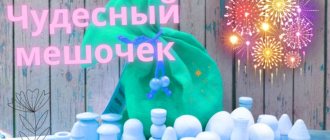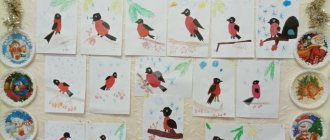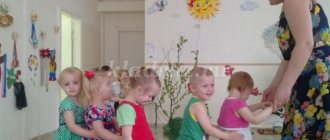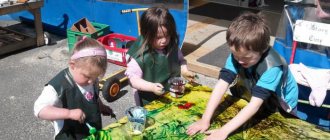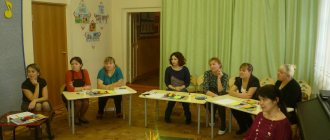Summary of GCD in the middle group. Digit and number 3
Lesson summary for children 4-5 years old “Number and number 3”
Author: Khashaeva Albina Aleksandrovna, teacher, Secondary School No. 74 (d/o), Moscow. Description of the material I offer you a summary of direct educational activities for children of the middle group on the topic “Number and number 3.” This is a summary of a lesson in which children become familiar with the concept of a number series, numerals from 1 to 3, and also learn to name them correctly and navigate them correctly. Purpose To familiarize yourself with the formation of the number 3 and the number of the same name;
teach to name the numerals 1, 2 and 3; arrange and count things from left to right with the right hand; learn to navigate in space. Materials
Materials for
the teacher : * ball * cards with numbers Materials for children : * cards with numbers 1, 2 and 3 * identical cubes - 6 pieces * cards with raspberries - 4 pieces * cards with strawberries - 4 pieces * number card Instead of the corresponding cards, you can take toys in the form of raspberries and strawberries.
Progress of the lesson
At the table (sitting) To begin, invite the children to place one cube. — How many dice did you bet? - Now show me this figure. — What figure did they show and why exactly? - Now to the right of the cube, make a column of 2 cubes. - How many cubes are there in this column? That's right, one, two, just two cubes. - What number should be used to denote 2 cubes? Show the number 2. - Now make another column of two cubes next to it and place another one on it. Are there more cubes? - Let's count together how many cubes are in the last column: one, two, three - 3 cubes in total. — The number 3 is indicated by the number 3 ( show
).
— Make sure that the 2nd and 3rd columns have an equal number of cubes - 2 each. Check the correctness of the task.
— What is the number of cubes in the 2nd column?
And in the 3rd? Place another cube in the 3rd column. How many cubes are there in the 3rd column now? Where are there more cubes: in the 2nd or 3rd column? Show the number that represents the number 3. Place the numbers 1 and 2 on the board.
- Where should the number 3 be? After what digit in the number series should it be placed?
Let's play the game
Game “What has changed?” On the board there is a row of numbers from 1 to 3. The guys close their eyes, the teacher removes the number 2. Opening their eyes, they name the “disappeared” number and put it in the right place in the row.
The next time, when the game is repeated, one of the children removes the number. For the first time, it is the number 2 that should be removed, because the children must see the boundaries of the number series. Physical education lesson
“Who is faster?”
— outdoor game Working with a card
The teacher allows the children to raise their right hand and tell individual children which hand they demonstrated.
After this he asks to demonstrate his left hand. Next, the children are asked to place their left hand on the card on the left side, and with their right hand to arrange the berries from left to right. — Place this many strawberries on the top “shelf” of the card. Indicates the number 2.
- How many strawberries are on the card?
Show me 2 strawberries. The guys make a circular gesture, circling two strawberries.
- Place the same number of raspberries at the bottom. How many raspberries did you put in? — What can you say about raspberries and strawberries? — Place another raspberry in the row. Which berries have become smaller? Which ones are there more? — What needs to be done to make them equal, 3 each? — What number should be placed next to raspberries and strawberries? Why this number?
Tips for parents
After the lesson, you can recommend to parents how to help children fix the number 3 in everyday life. For example, put 3 cups on the table and ask the question: “How many plates and spoons should be placed if there are 3 people eating?”
We recommend watching:
Summary of a comprehensive lesson on FEMP with elements of application in the middle group. Summary of a lesson in mathematics in the middle group of kindergarten. Synopsis of a game-based cognitive lesson on FEMP in the middle group. Synopsis of joint activities on mathematical development for children of the middle group.
Similar articles:
Math lesson “Rectangle” in the middle group of kindergarten
Mathematics lesson “Ordinal counting” in the middle group
Program content
Learn to form the number 3 from two smaller numbers and decompose it into two smaller numbers.
Continue familiarizing yourself with numbers from 1 to 9.
Clarify your understanding of a polygon, develop the ability to find its sides, angles and vertices.
Strengthen ideas about the seasons and months of autumn.
Didactic visual material
Demonstration material.
2 sets of cards with numbers from 0 to 9 (two colors), 3 yellow and 3 dark yellow circles, pictures of a fox and a cat, a square made of counting sticks, a picture of a fox made of polygons, a model “Seasons” "
Handout.
Counting sticks (4 pieces for each child), 3 yellow and 3 red circles (for each child), plasticine, envelopes with geometric shapes.
Guidelines
Part I. Game exercise “Make a number”.
The teacher reminds the children of the plot of A. Tolstoy’s fairy tale “The Golden Key”. Then he lays out 3 yellow circles on the flannelgraph and says that these are 3 gold coins belonging to the cat Basilio and the fox Alice. The teacher clarifies: “How many coins are there in total? How many coins of what color? How did you come up with the number three? (One, one and one more.)
The teacher tells the children that Alice the fox and Basilio the cat are trying to divide the coins between themselves. The teacher replaces the last circle with a dark yellow circle and asks: “How many coins does Alice have? How many coins of what color? How did Alice get three coins? ( Two and one coin.)
Children place the corresponding numbers under the coins.
“Basilio the cat suggests dividing the coins differently: one yellow coin and two dark yellow ones,” continues the teacher. – How many coins does Basilio have? How many coins of what color? How did Basilio get three coins?” (One yellow and two dark yellow.)
Children put out numbers 1 and 2.
The teacher continues: “Alice the Fox claims that two and one will be three and one and two will also be three. Is Alice right? (Children express their guesses.)
Part II. Game exercise “Let's help the cat Basilio and the fox Alice divide three coins.”
The teacher gives the children the task: “Make the number three using yellow and red circles: place circles of one color on the left and the other on the right.”
After completing the task, the teacher asks the children how they made up the number 3 (2 and 1, 1 and 2).
Then the teacher invites the children to divide 3 coins equally between the cat Basilio and the fox Alice. The teacher listens to the children's answers and concludes: “You cannot divide three coins equally, since the number three consists of the numbers two and one or one and two.”
Part III. Outdoor game “Whose team will assemble faster?”
Children are divided into two units of 10 people each. Each child takes one card with a number from 0 to 9. (Each section of the card has its own color.) The rest of the children are the judging team.
Children perform various movements to music. With the end of the music, the links are built in order (from 0 to 9). The judging team checks the correct formation of the children.
Then the children change roles and cards and the game is repeated 2-3 times.
At the end of the game, the teacher asks each unit to indicate the number of players using a number. The teacher discusses with the children what numbers they used to represent the number 10 and which side of the unit 0 is located on.
Part IV. Didactic game "Tangram".
Children have 4 counting sticks and a piece of plasticine. The teacher invites the children to compare the lengths of the sticks and connect them using plasticine. Then he clarifies: “What figure did you get? (Square.)
What does a square have?
(Sides and angles.)
How many sides does a square have? How many angles?
The teacher shows the same model of a square and explains (at the same time showing) that the point where the sides of the square connect is called the vertex. The teacher asks the children to show and count the vertices of the squares.
“What else can you call a square? – the teacher clarifies. “That’s right, a polygon (quadrangle).”
The teacher invites the children to take out the figures for the game “Tangram” from the envelopes and asks: “What are the names of the figures? How else can they be called in one word? What do these figures have? (Sides, corners, vertices.)
Now let's assemble the fox Alice from geometric shapes. (Shows a sample.) What polygons did you use to make the fox?”
Part V Game exercise “Seasons”.
The teacher shows the children the “Seasons” model: a square divided into 4 parts (seasons), colored red, green, blue and yellow. The yellow part is divided into 3 more parts, colored in light yellow, yellow and yellow-brown.
The teacher asks the children: “How many seasons are there in total? Name them in order. (Shows the seasons on the model, specifying the color and their names.)
Show autumn on the model. How many parts is this season divided into? Why do you think there are three parts? What months of autumn do you know? The last month of autumn is November. Name the months of autumn in order." (September October November.)
The teacher shows the months on the model.

